I personally cold not pick up the ringing at 4khz
And I was just as surprised as you are by the length of the cone ringing, seemed weird to me too, that's also why I'm waiting for someone to validate the measurements.
Length of cone ringing means lack of dampening. It is the difference between plucking a string and plucking it with your finger resting on it. All materials have points of resonance. The more spread out they are, the better. The idea of adding a massive low durometer material is to dampening the resonance, like your finger on the string. The idea of the pattern spaced dots is to break up single frequency resonances to many so each is not as significant.
Look on the "what's the attraction" thread. The 125 rings like a freeking bell. Others may not, but a 10dB resonance peak at 7K does not sound like an extended top end to me. It sounds like a cheap desktop radio and I would be concerned with the IM it is causing in the most sensitive ranges.
With some doping (I used artist gesso which is actually kind of a glue) I was able to help it quite a bit. I am looking forward to hearing a set done by Planet10 to see if I am anywhere near his mark. I doubt it as he has a lot of experience with this.
It seems the 125 is at just the wrong size for the cone material. Just larger and just smaller seem to be far better. You can even see that in their published charts. The very best treatment I can think of for this driver is a steep crossover. It is one of the flattest mid-ranges I have seen. LR-4 @ 2K seemed to be fine. When pushed to 3K, I had to add a notch at 7K to keep the main resonance more than 12 dB down. As I found tweeters that are happy at 2K, and mid-woofers happy at 2K, I don't need the complication of a mid-range.
So, why do manufactures insist on using highly resonant cones? Yes, they have a very good reason. They are more rigid and within their useable range, that means lower distortion. The paper in the 125 is very stiff. Low distortion, but breakup issues. It is much like many of the metal cones in that respect. Being paper, it is easy to modify into a "bonded cellulose fiber composite" and achieve results that are outside of the OEM's product price point.
I would have to agree with Tvr here, might add that it is pretty good speaker, but it's going to need help, cone treatment, filter. The driver cost is nice, the savings can be used for fine tuning (once we figure out what that is).
Btw, It does take about 200 hours to break them in.
Also, agree with earlier post, small changes make noticeable differences.
Btw, It does take about 200 hours to break them in.
Also, agree with earlier post, small changes make noticeable differences.
Last edited:
and the mica (talc powder) added to poly drivers are starting to sound really nice also.
Norman
My Kef Q1's are mica filled I think. They still sound like poly though. I am being rough on them, but I do remember they were only about $300 a pair and I bought them off e-bay for a lot less. For my ears, I still keep falling back on paper. I just love the Seas reed paper mid-bass I used in my last build. Easy to use. No filtering, no muss, and works in half a cubic foot. The ScanSpeaks and Ushers need bigger boxes. Someday when I save up for it, I want to try the Seas mag cone mid-bass. I am no longer anti-metal as I have learned a lot about using them, just still pro-paper. I'll have to wait to hear a poly cone that does not sound like mush. My biases change as fast as they can be proven wrong.
I think the main reason paper is so popular, is the immense variation in composition that is possible. Some kapok, cotton even, wool. composites are most definitely that way, and paper is probably the most versatile.
I used to have a penchant for modern composites, which has faded thankfully. Random fibrous composites containing both natural and synthetic fibres are most interesting to me.
Unfortunately, the immense scope for differing stiffness, hardness, and weight is a double edged sword.
you never quite know what your getting with paper, until you hear it
Since my 1st ever pair of DIYs I havent used paper. I changed from the paper Audax I was using, to the HDA version. I was blown away by the detail I just couldnt hear through the (mild and smooth) breakup of the paper cone. But at least it was smooth.
Harder paper would perhaps reveal more detail (I hate the word too), but introduce a more resonant nature to the material.
I am still wary of metal cones, but I own some, and they are by far the best speakers Ive ever had/heard. It is frustrating that the resultant crossover (if used) requires more work. The Seas Mg cone breakups are just crazy, and even the small FR drivers like Mark audio A6, fountek etc need some crossover work IMHO.
Id get the paper A6P, but again, paper as a medium is just sooo damned variable.
So now Ive bought some more paper cones, albeit because they were cheap. despite this theyre very dead, damped paper. Less detail than the AL cones I use, but I may finally get to go minimalist with the crossovers/EQ.
(I know this is in fullrange, but I think that there is probably more variabilty in paper types, hardness etc than in multiway drivers. Its probably MORE relevant in a FR driver)
To use the awful word:detail yet again, I would say Ive also never heard a poly cone that I liked. They seem to be similar to paper (perhaps more humidity stable?), but less detail than paper. I cant imagine id like a polycone FR driver at all, but perhaps thats shortsighted of me.
very fine fibrous composites using paper, and polyfibres could be good. I have no idea if there are any such drivers out there.
If I got the chance to make my own paper cone maybe id use:
fibrous Nylon
fibrous glass (again though, glass is pretty variable)
fibrous polypropylene
kevlar
Carbon fibre
wood fibre
cotton
wool
hemp
paraffin wax
maybe itd work, maybe its be a mess
maybe id even try a fine (2000 TPI) weave of a metallic alloy. That might be interesting.
Right im off to win the lotto, and set up my laboratory
Oh yes.......the real point of posting
Ive always found that judicious use of PVA wood glue (the stuff thats 'stronger than the wood itself'©) has merit in taming some nasty breakups. Ive never tried dots, and I dont believe NABL is really anything you couldnt experiment with at home. A ring of PVA or helical spokes (like the slits on revelators) would probably serve to do a similar thing to dots. Might even be worth trying rubber solution glue, but itd look awful no doubt
I used to have a penchant for modern composites, which has faded thankfully. Random fibrous composites containing both natural and synthetic fibres are most interesting to me.
Unfortunately, the immense scope for differing stiffness, hardness, and weight is a double edged sword.
you never quite know what your getting with paper, until you hear it
Since my 1st ever pair of DIYs I havent used paper. I changed from the paper Audax I was using, to the HDA version. I was blown away by the detail I just couldnt hear through the (mild and smooth) breakup of the paper cone. But at least it was smooth.
Harder paper would perhaps reveal more detail (I hate the word too), but introduce a more resonant nature to the material.
I am still wary of metal cones, but I own some, and they are by far the best speakers Ive ever had/heard. It is frustrating that the resultant crossover (if used) requires more work. The Seas Mg cone breakups are just crazy, and even the small FR drivers like Mark audio A6, fountek etc need some crossover work IMHO.
Id get the paper A6P, but again, paper as a medium is just sooo damned variable.
So now Ive bought some more paper cones, albeit because they were cheap. despite this theyre very dead, damped paper. Less detail than the AL cones I use, but I may finally get to go minimalist with the crossovers/EQ.
(I know this is in fullrange, but I think that there is probably more variabilty in paper types, hardness etc than in multiway drivers. Its probably MORE relevant in a FR driver)
To use the awful word:detail yet again, I would say Ive also never heard a poly cone that I liked. They seem to be similar to paper (perhaps more humidity stable?), but less detail than paper. I cant imagine id like a polycone FR driver at all, but perhaps thats shortsighted of me.
very fine fibrous composites using paper, and polyfibres could be good. I have no idea if there are any such drivers out there.
If I got the chance to make my own paper cone maybe id use:
fibrous Nylon
fibrous glass (again though, glass is pretty variable)
fibrous polypropylene
kevlar
Carbon fibre
wood fibre
cotton
wool
hemp
paraffin wax
maybe itd work, maybe its be a mess
maybe id even try a fine (2000 TPI) weave of a metallic alloy. That might be interesting.
Right im off to win the lotto, and set up my laboratory
Oh yes.......the real point of posting
Ive always found that judicious use of PVA wood glue (the stuff thats 'stronger than the wood itself'©) has merit in taming some nasty breakups. Ive never tried dots, and I dont believe NABL is really anything you couldnt experiment with at home. A ring of PVA or helical spokes (like the slits on revelators) would probably serve to do a similar thing to dots. Might even be worth trying rubber solution glue, but itd look awful no doubt
Last edited:
Well I looked at the graph and I see a rise starting a 6 khz and topping off at 7 khz and going back down at 8 khz. If I am reading and seeing this right. I would and I really try never to go this way to crossover the ff125wk at 5 khz and then cross a tweeter in at 4.5 khz if I am doing this right? I have not done a crossover in years so if I am wrong please bear with me. This is what I would do a 6 or 12 DB crossover and the peakness is solved. Jm
Well I looked at the graph and I see a rise starting a 6 khz and topping off at 7 khz and going back down at 8 khz. If I am reading and seeing this right. I would and I really try never to go this way to crossover the ff125wk at 5 khz and then cross a tweeter in at 4.5 khz if I am doing this right? I have not done a crossover in years so if I am wrong please bear with me. This is what I would do a 6 or 12 DB crossover and the peakness is solved. Jm
Well, after listening extensively to the FF125WK's over the weekend, I can safely say that these don't need any tweeter help (at least to my ear), and the peak at 7khz (6,7khz actually) becomes much less objectionable once you apply the zig 2-way glue to the back of the surround and listen a bit off-axis (5-10 degrees)
Regards
Nick
Well I looked at the graph and I see a rise starting a 6 khz and topping off at 7 khz and going back down at 8 khz. If I am reading and seeing this right. I would and I really try never to go this way to crossover the ff125wk at 5 khz and then cross a tweeter in at 4.5 khz if I am doing this right? I have not done a crossover in years so if I am wrong please bear with me. This is what I would do a 6 or 12 DB crossover and the peakness is solved. Jm
Look at the SCALE of the graph. It is not slight!
Nick, you actually put the glue on the surround itself, not on the cone where the surround attaches?
We want a cone that is stiff to get low distortion, very light to get some HF without a wizzer, and breakup modes above the audible range. I don't know of that material. Beryllium is probably a good material, but it is horrible to manufacture and is rather toxic, let alone very expensive. Cone shape can do a lot for spreading out resonances, but usually means less stiffness. (See the early RCA papers)
It all sort of comes back to a driver being suitable for about a decade range. That of course kind of kills the full range concept unless it is for a phone ( 300 to 3300 Hz)
The Walsh driver could be argued to be a full range very steep cone that decoupled regions of the cone to work semi-independently. Ohm is still out there selling direct.
We want a cone that is stiff to get low distortion, very light to get some HF without a wizzer, and breakup modes above the audible range. I don't know of that material. Beryllium is probably a good material, but it is horrible to manufacture and is rather toxic, let alone very expensive. Cone shape can do a lot for spreading out resonances, but usually means less stiffness. (See the early RCA papers)
It all sort of comes back to a driver being suitable for about a decade range. That of course kind of kills the full range concept unless it is for a phone ( 300 to 3300 Hz)
The Walsh driver could be argued to be a full range very steep cone that decoupled regions of the cone to work semi-independently. Ohm is still out there selling direct.
Nick, you actually put the glue on the surround itself, not on the cone where the surround attaches?
The latter
I liked the poly/mica mw144 by morel (5") crossed I've no clue.
And I don't have much experience otherwise, but I was looking at the scanspeak paper/kevlar thing 18w/8545-000.
It's a 7" used in in the Odyssey Loreili speaker.
Odyssey Audio: Lorelei floorstanding speaker. Call us (317) 299 5578. IN, USA.
Madisound Speaker Store
Odyssey Khartago Candela Lorilei review
6moons audio reviews: Odyssey Audio Lorelei
But that's for a 2 way.
I believe wild burro betsy went away from kevlar/paper back to all paper drivers. He said they sound better.
Norman
And I don't have much experience otherwise, but I was looking at the scanspeak paper/kevlar thing 18w/8545-000.
It's a 7" used in in the Odyssey Loreili speaker.
Odyssey Audio: Lorelei floorstanding speaker. Call us (317) 299 5578. IN, USA.
Madisound Speaker Store
Odyssey Khartago Candela Lorilei review
6moons audio reviews: Odyssey Audio Lorelei
But that's for a 2 way.
I believe wild burro betsy went away from kevlar/paper back to all paper drivers. He said they sound better.
Norman
Look at the SCALE of the graph. It is not slight!
Well I could have miss used words. To me it's not as bad as a lot of other fullrange drivers I have seen.jm
Well, after listening extensively to the FF125WK's over the weekend, I can safely say that these don't need any tweeter help (at least to my ear), and the peak at 7khz (6,7khz actually) becomes much less objectionable once you apply the zig 2-way glue to the back of the surround and listen a bit off-axis (5-10 degrees)
Regards
Nick
I have a question whats this zig- 2 way glue I have never heard of it? Why would you put it on the back of the surround? Didn't fostex already use glue on this surround? Have you done a stock and a driver with glue on it side by side testing? Just seems odd that you would have to mess with the drivers to get them to sound right after they have been built by fostex and sent out? Please explain? I hope I am not sounding rude just wondering? Thanks Mr. jeff
P.s. I googled the gule zig-2 way and found it a k-mart. jm
Last edited:
jm,
On that note, can you post a pic of the floor standing boxes?
I have several 125wks pics...but nothing new to post.
On that note, can you post a pic of the floor standing boxes?
I have several 125wks pics...but nothing new to post.
Well now for my 2. I just put the Fostex FF 125wk in a floor standing speaker boxes I made back in march if this year. It is a rear ported trapezoid box.
jm,
On that note, can you post a pic of the floor standing boxes?
I have several 125wks pics...but nothing new to post.
Yes I would love to but, How would I go about posting the pictures? I will try to figure it out? Jm
very easy....go to "Go Advanced" click paper clip....upload from your pic folder (or where ever)
Got ya I will try that thanks.Jm
Last edited:
I have a question whats this zig- 2 way glue I have never heard of it? Why would you put it on the back of the surround? Didn't fostex already use glue on this surround? Have you done a stock and a driver with glue on it side by side testing? Just seems odd that you would have to mess with the drivers to get them to sound right after they have been built by fostex and sent out? Please explain? I hope I am not sounding rude just wondering? Thanks Mr. jeff
P.s. I googled the gule zig-2 way and found it a k-mart. jm
Not rude, worry not
The zig is applied to the back of the cone, on the portion where the surround in glued to the cone. The glue stays sticky and is used to damp what BudP (Bud Purvine, he's the one behind the concept) thinks are raleigh waves affecting the cone's resonance.
In the first 2 pages of this thread I have posted waterfall plot measurements (time decay measurements) of the same driver before and after applying the glue...
The plots quite strikingly show the differences, but I'm still waiting for someone to duplicate the results just to make sure my measurements are not faulty.
Regards
Nick
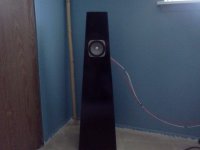
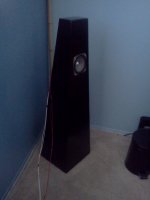
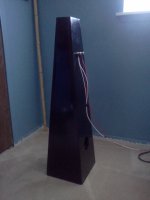
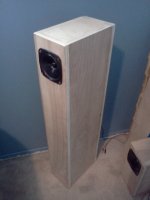
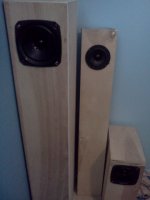
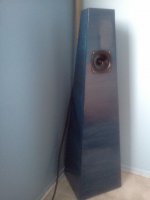
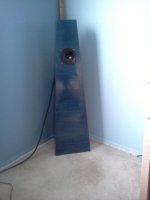
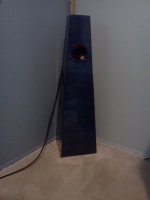 1.Well here are my trapezoid boxes I made back in march of this year. Here are the ff125wk drivers in them and they sound very good indeed. I have changed the color of the boxes and the wires inside and out and 2 types of stuffing and 2 types of damping on the side walls and behind the drivers. I upgraded the binding post to better binding post. I have left the ff125wk drivers as stock. You can see the front,side and back with a port close to the bottom of the boxes. This is my own design inside of the box. The outside I thank the late terry cain and anyone else who has had a tilled box all around a trapazoid box. I am working on a way to make the air flow more smoother and better out of my boxes. I already have a proto type in this box. The next one will be even better at the air flowing thru the boxes.I think its all together thinking not just inside the box but, outside as well and around the drivers as well. I am pretty close on having a box that works well with the stock fe126en drivers with out modding the cones. Sorry dave at planet 10 I know your stuff is good and bud has a great product but, its like ice cream. You like mint and I like superman. I am seeing if I can build a box around the fe126en drivers to cure the peakness? Never know this could work? Now Theres a sucker born very minute but, I am not a sucker and I enjoy a good challenge. More to come. Also it was a killer to cut all the angles by hand with a cirular hand saw. I had to hold the wood down yes I used clams so it would not move. I had a kinda broken table I was using by my self. I did have someone helping me but,it To long of a story to type here. Well again I can't wait to build my next pair saving up now.
1.Well here are my trapezoid boxes I made back in march of this year. Here are the ff125wk drivers in them and they sound very good indeed. I have changed the color of the boxes and the wires inside and out and 2 types of stuffing and 2 types of damping on the side walls and behind the drivers. I upgraded the binding post to better binding post. I have left the ff125wk drivers as stock. You can see the front,side and back with a port close to the bottom of the boxes. This is my own design inside of the box. The outside I thank the late terry cain and anyone else who has had a tilled box all around a trapazoid box. I am working on a way to make the air flow more smoother and better out of my boxes. I already have a proto type in this box. The next one will be even better at the air flowing thru the boxes.I think its all together thinking not just inside the box but, outside as well and around the drivers as well. I am pretty close on having a box that works well with the stock fe126en drivers with out modding the cones. Sorry dave at planet 10 I know your stuff is good and bud has a great product but, its like ice cream. You like mint and I like superman. I am seeing if I can build a box around the fe126en drivers to cure the peakness? Never know this could work? Now Theres a sucker born very minute but, I am not a sucker and I enjoy a good challenge. More to come. Also it was a killer to cut all the angles by hand with a cirular hand saw. I had to hold the wood down yes I used clams so it would not move. I had a kinda broken table I was using by my self. I did have someone helping me but,it To long of a story to type here. Well again I can't wait to build my next pair saving up now. 2. The next set of pictures are the fe126en drivers I mod. the cone and the basket. I have them in a corner loaded horn box sounded muffled. Then with all 2 of them. I have the corner loaded horn box with a t.l. tang band box sounded to dull next to the fostex. Then the book shelf is a fe126en driver in a front ported bass reflex sound okey to small for this driver.
3. The same box as #1. but, a different finish and clear coating and and the wires and stuffing and damping in the boxes. I built this box around the fe126en drivers but, the boxes are to tall and need to be deeper. I will be reworking this type of box in my next project. I took them to a local hi-fi shop and theytold me I could market my product. Well its been alot of hours testing and more to come. Jm
Last edited:
Not rude, worry not
The zig is applied to the back of the cone, on the portion where the surround in glued to the cone. The glue stays sticky and is used to damp what BudP (Bud Purvine, he's the one behind the concept) thinks are raleigh waves affecting the cone's resonance.
In the first 2 pages of this thread I have posted waterfall plot measurements (time decay measurements) of the same driver before and after applying the glue...
The plots quite strikingly show the differences, but I'm still waiting for someone to duplicate the results just to make sure my measurements are not faulty.
Regards
Nick
Okey sounds good. If the glue stays sticky will that attract dust? I Just thinking more dust more problems?Just a thought? jm
Last edited:
- Status
- This old topic is closed. If you want to reopen this topic, contact a moderator using the "Report Post" button.
- Home
- Loudspeakers
- Full Range
- taming harshness of fostex FF125WK